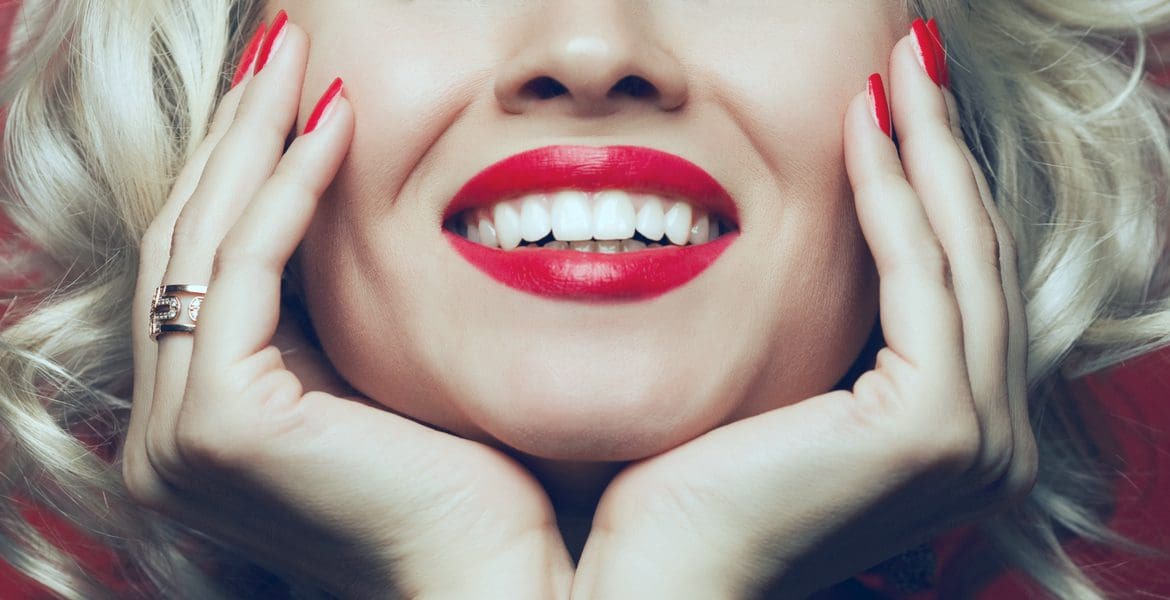When teeth are looking a dingy shade of yellow instead of pearly white, scrambling for a lipstick with blue undertones may distract but won’t disguise the truth. You’ve been hitting the coffee hard, and now your teeth are stained an unlovely shade. Restoring a brighter smile will depend on how much time and money you want to invest.
You inherit much of the characteristics of your teeth—color, quality and type of enamel—from your ancestors. Genetics may have given you a thicker, opaque layer of enamel that makes teeth whiter and brighter. More translucent enamel reveals the yellow inner part of the tooth.
However, you can make choices to reduce yellowing. Any dark drinks such as wine, tea, and coffee that has the potential to stain your clothes will also stain your teeth. Tobacco, certain prescription drugs, plaque and bacteria can add to discoloration. Another cause of yellowing is aging. The inner part of teeth, dentin, naturally yellows as it ages. Grinding teeth and trauma such as falls and accidents can prematurely age the teeth. Poor diet lacking vitamins and minerals can prematurely age teeth and result in yellowing.
The best teeth whitening trick is to avoid stains in the first place. Dentists recommend avoiding staining foods and beverages, drinking lots of water, swishing with water after meals, seeking treatment for grinding and wearing a mouthguard during sports to protect teeth.
Professional whitening is effective but is expensive; some can whiten your teeth up to 10 shades in one hour and some require several sessions. If you are looking to go the home whitening route, head to your local drugstore and pick up some Crest White Strips. Whitening strips are bleaching strips that hold teeth whitening gel against your teeth to remove stains below the enamel surface. The gel contains peroxide that bleaches color from your teeth to restore their natural, white color. Use these strips as directed, and you should see a difference in a couple days if you use them once a day. Make sure to brush and floss your teeth first and that your teeth are dry when you place the strips on. Whitening strips can cause sensitivity, so it’s recommended that you switch off top and bottom teeth each time.
Check the label to make sure chlorine dioxide is not an ingredient in your whitening strips gel. Chlorine dioxide is the same acid used to disinfect swimming pools, and it eats away at the surface of the enamel to whiten teeth.
Maintaining brilliance requires commitment to daily brushing and flossing along with abandoning food and drink that stains teeth. If you can’t give up the coffee, use a straw. It will help with any front teeth stains. For the person who wants maximum benefit from their teeth-whitening, there’s whitening toothpaste.
Whitening toothpaste doesn’t penetrate deeper into the tooth like bleaching but removes superficial surface stains with an abrasive element. Some dentists caution against using whitening toothpaste more than once a week to remove a week’s indulgence in coffee and red wine.
You may have heard of using apple cider vinegar, strawberries or baking soda to whiten teeth. Doctors caution that these methods reveal whiter enamel because acids in these products eat away the top layer of enamel. The process whitens teeth but also speeds up the aging process of your teeth. Using these natural products leads to further yellowing and eventual damage.
One natural product that you may want to explore is activated charcoal toothpaste. This toothpaste is available on the market and you can also find DIY recipes online. Another natural tooth whitener is turmeric mixed with coconut oil. There’s always another healthy alternative right around the corner, so before you go to the dentist for harsh whitening, try these natural remedies.






